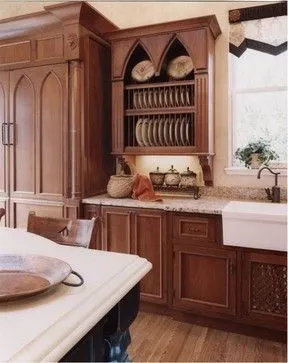What is Gothic Kitchen Decor
Gothic kitchen decor is a design style that embraces the dark, dramatic, and ornate aesthetic of the Gothic period. It’s a way to transform your kitchen into a space that evokes a sense of mystery, history, and elegance. This style is characterized by its use of dark colors, intricate details, and often, a connection to historical architecture. Think of the grand cathedrals and castles of the past, and you’ll have a good starting point for envisioning a Gothic kitchen. Unlike the minimalist or overly bright kitchens, gothic kitchens create a moody ambiance and a unique statement, perfect for those who appreciate a touch of the macabre and a love for historical design.
The Historical Roots of Gothic Style
The Gothic style emerged in Europe during the medieval period, specifically from the mid-12th century to the late 16th century. It was a revolutionary architectural and artistic movement, born from the Romanesque style. Gothic architecture is best known for its soaring arches, pointed vaults, and intricate ornamentation, which were all aimed at creating a sense of grandeur and reaching towards the heavens. This style wasn’t just limited to architecture; it also influenced art, furniture, and decorative arts, shaping a distinct aesthetic that continues to captivate designers and homeowners today. Understanding the historical roots of Gothic style provides the foundational elements for incorporating it into your kitchen design, allowing you to capture its essence and atmosphere.
Key Elements of Gothic Architecture
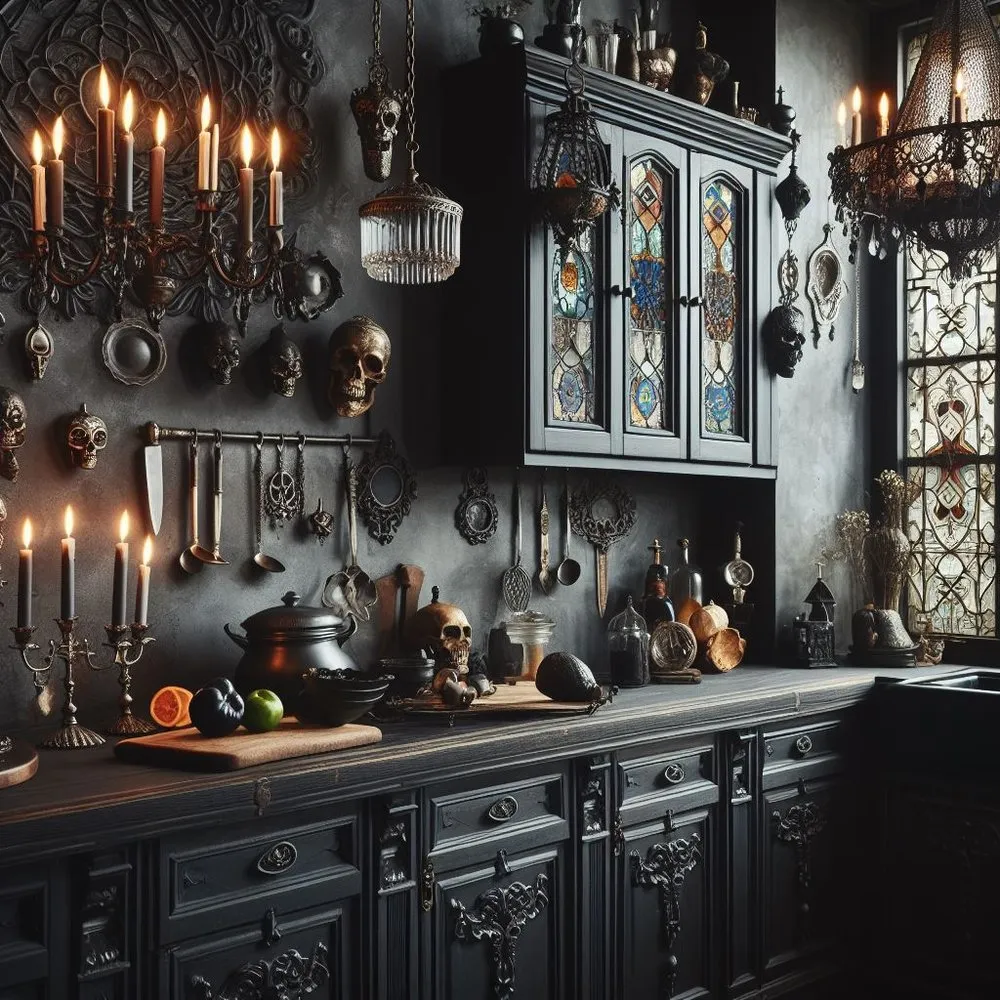
Several key elements define Gothic architecture. Pointed arches are one of the most recognizable features, providing structural support and a sense of verticality. Ribbed vaults, another structural innovation, allowed for larger and more open interior spaces. Flying buttresses were developed to support the weight of the walls, enabling the construction of tall structures with large windows. Elaborate tracery, the ornamental stonework found in windows and other architectural elements, added intricate patterns and visual interest. Stained-glass windows were a critical component, filling spaces with colored light and telling stories through imagery. These elements serve as inspiration when designing a Gothic kitchen, offering a rich source of ideas for incorporating similar design features, which include archways, detailed molding, and ornate patterns.
Implementing Gothic Design in Your Kitchen
Bringing the Gothic aesthetic into your kitchen involves incorporating various design elements that reflect the style’s key characteristics. Start by considering the overall mood you want to create. Do you lean towards a dark and mysterious ambiance, or a more refined and elegant look? Choosing a color palette is crucial, selecting deep, rich colors like black, deep reds, and purples, or even muted jewel tones. Pay close attention to the textures and materials that you incorporate. Consider using materials like dark wood, stone, and iron to capture the Gothic aesthetic. Moreover, incorporate ornate hardware, like wrought-iron handles, and choose fixtures that reflect the historical style to enhance the overall ambiance. The key is to balance the dramatic elements with practicality, creating a kitchen that is both visually striking and functional.
Color Palette for a Gothic Kitchen
The color palette is central to a gothic kitchen design. Dark, moody colors such as black, charcoal gray, deep burgundy, and forest green, are often the foundation. These hues provide a sense of depth and create a dramatic backdrop for other elements. To prevent the space from feeling overly dark, incorporate lighter accents and textures. Gold, silver, or copper metallic touches can introduce visual interest. Consider a contrasting light countertop with dark cabinets or using light-colored tiles to offset darker walls and floors. Carefully balancing the colors creates a harmonious and visually stunning space that still reflects the Gothic style’s essence. The use of colors should be thoughtful, considering how they interact with light and affect the overall feeling of the kitchen. Colors can set the scene in your kitchen, creating a bold, mysterious, or elegant feel.
Dark and Moody Colors
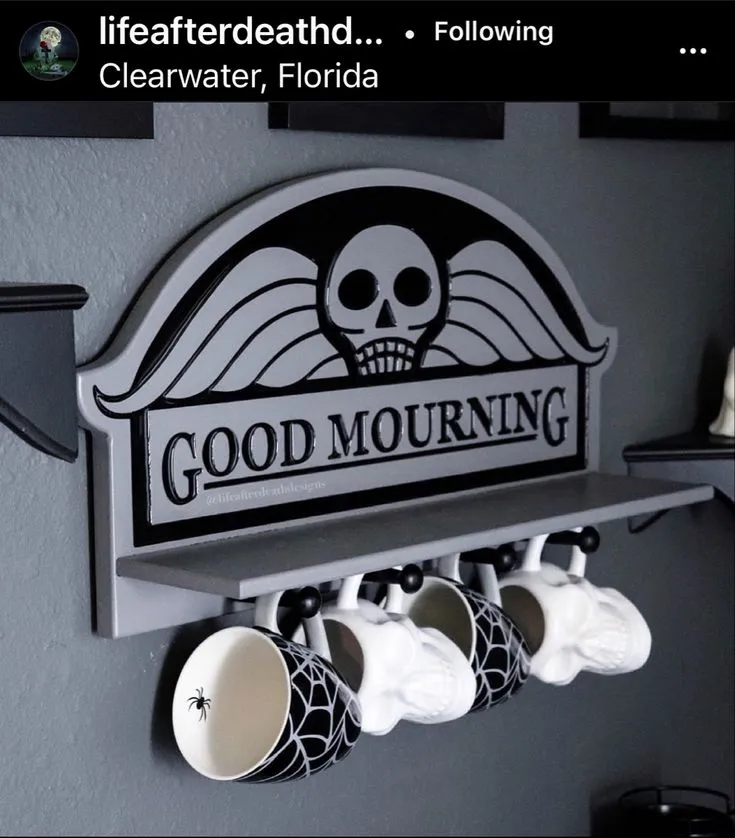
When selecting dark and moody colors, consider the impact of each shade on the overall ambiance. Black and charcoal gray are excellent choices for cabinets, walls, or even countertops, creating a sophisticated and dramatic effect. Deep burgundy or plum can add a touch of luxury and richness, evoking a sense of history and elegance. Forest green, a color found in many Gothic settings, brings a natural element, while still maintaining the dark atmosphere. When using dark colors, ensure adequate lighting to prevent the kitchen from feeling cramped. Using a combination of natural light, ambient lighting, and task lighting creates balance. The lighting can also be adjusted to create a mood, providing both functionality and aesthetic appeal. Experiment with paint swatches and materials samples to envision the impact of various color choices on the space.
Incorporating Textures and Materials
Texture plays a crucial role in a Gothic kitchen, adding visual interest and depth. Materials like dark, stained wood are ideal for cabinets, flooring, and furniture, evoking a sense of history and solidity. Stone, whether used for countertops, backsplashes, or flooring, provides a natural, rugged aesthetic that pairs well with the Gothic style. Consider using textured tiles to add visual complexity, or opt for a brick backsplash for a touch of rustic elegance. Wrought iron is another essential material, ideal for hardware, lighting fixtures, and decorative accents. The play of textures can add depth, ensuring a cohesive and visually appealing design. Choose materials that complement each other and create a tactile experience within the space. A balance of rough and smooth surfaces will provide depth and complexity.
Selecting Gothic Kitchen Furniture
Furniture selection is key to achieving a Gothic look. Choose pieces that reflect the style’s ornate and historical qualities. Dining tables should be robust, preferably made of dark, solid wood, with carved details or intricate bases. Chairs can feature high backs, detailed carvings, or upholstered seats in rich fabrics like velvet or damask. Consider adding a buffet or hutch with glass-fronted cabinets for displaying china and glassware, which adds to the elegant appeal. Antique or vintage furniture is ideal, as it carries the historical authenticity of the style. Look for pieces with unique shapes, carved details, and dark finishes. Balancing the historical furniture with modern elements can create a kitchen that is both stylish and functional, reflecting a harmonious blend of old and new. Furniture choice should create a cohesive aesthetic.
Choosing Cabinets and Countertops
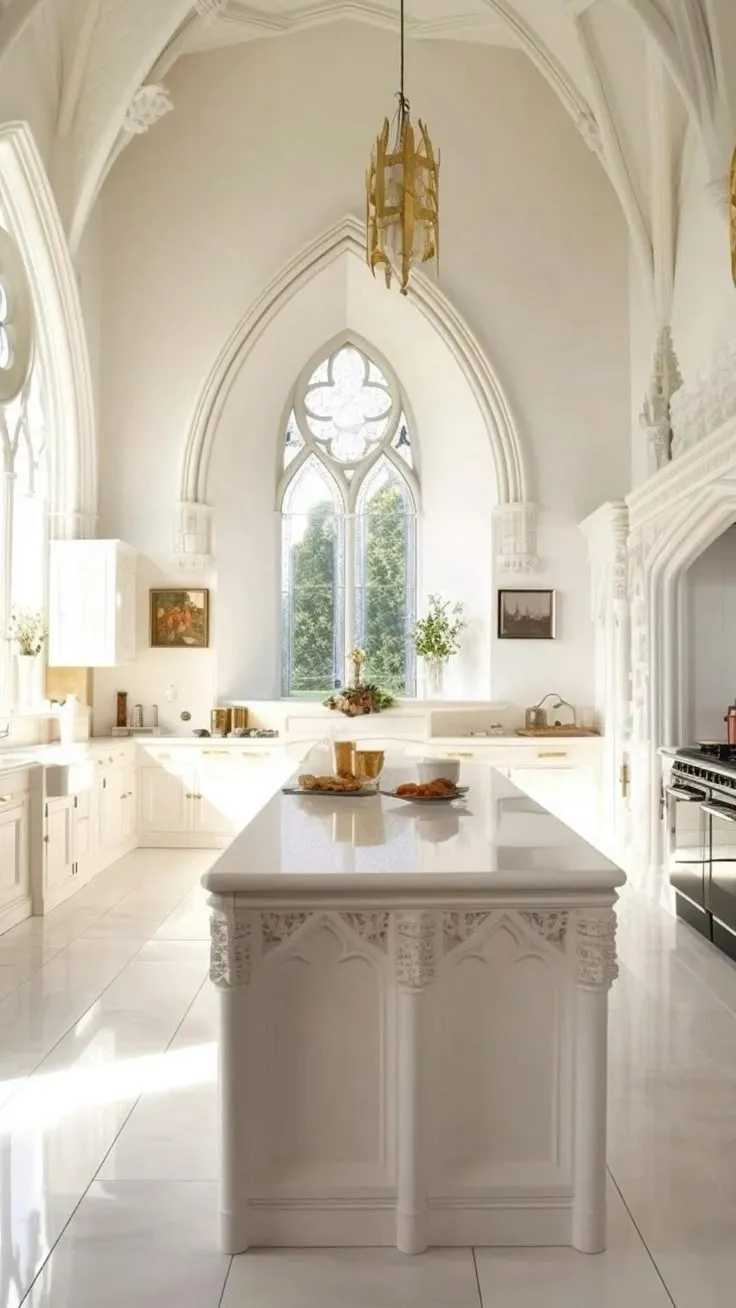
Cabinets set the stage for the kitchen’s Gothic aesthetic. Dark-stained wood cabinets are a perfect starting point, with options including black, deep brown, or even dark gray. Consider incorporating carved details, arched doors, or intricate moldings to reflect the Gothic style’s ornamentation. For countertops, opt for materials that complement the cabinets. Granite or marble in dark colors, such as black or deep green, add elegance and sophistication. If you want something unique, consider a stone or concrete countertop. Choosing materials with character creates visual contrast and depth in the kitchen. The choice of hardware for the cabinets, such as wrought-iron pulls or ornate knobs, completes the look, further enhancing the Gothic theme. Matching the cabinetry and countertops completes the overall look.
Gothic-Inspired Hardware and Fixtures
Hardware and fixtures are essential to adding Gothic details. Select handles, knobs, and pulls made of wrought iron or aged bronze, as these materials provide an authentic touch. Choose cabinet hardware with ornate designs, such as fleur-de-lis patterns or pointed arches, that reflect the historical Gothic style. Lighting fixtures play a vital role in creating the ambiance. Chandeliers with candelabra-style bulbs, wrought-iron pendants, and sconces with intricate detailing can add a dramatic feel. Consider fixtures made of metal or with dark finishes, incorporating crystals or decorative glass to enhance the luxurious effect. The right choice of hardware and fixtures can make a dramatic impact, accentuating the Gothic style. Lighting choices will create a strong ambiance.
Adding Gothic Decorative Elements
Decorative elements are essential to completing the Gothic aesthetic. Wall decor is an excellent area to start. Hang framed artwork such as dark landscapes, portraits, or religious-themed paintings to echo the historical style. Adding mirrors with ornate frames or stained-glass panels contributes to the mysterious feel. Consider incorporating vintage or antique items like candelabras, pewter, and other antique kitchen utensils. Displaying decorative dishware, such as dark-colored china or glassware, adds to the visual appeal. Accessories such as gothic-style vases or decorative boxes can add an aesthetic touch to countertops or shelves. Balance the elements to prevent the space from feeling cluttered. The decorative elements and accessories should have a cohesive style.
Wall Decor and Artwork
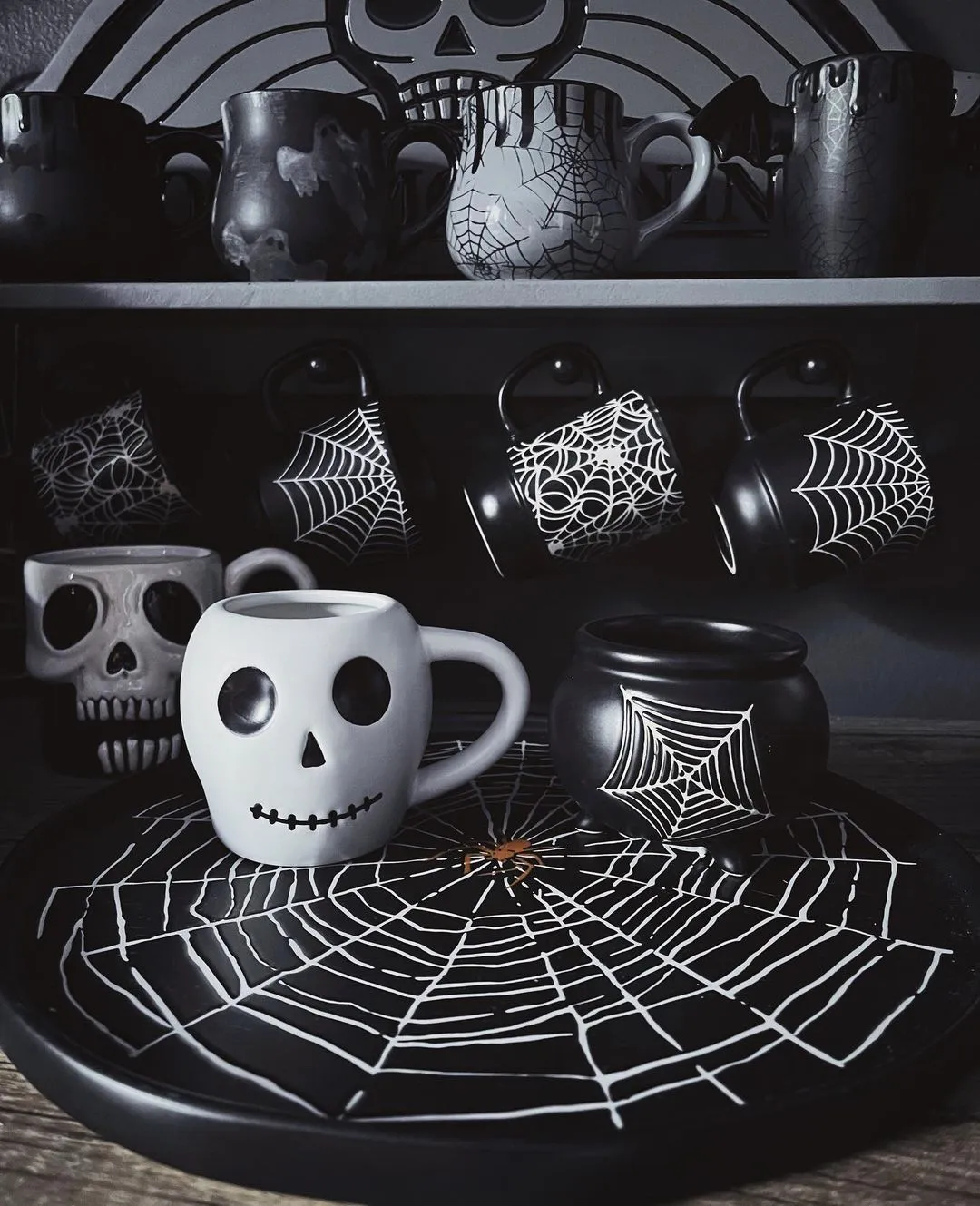
Wall decor and artwork can dramatically influence the Gothic kitchen’s atmosphere. Selecting artwork that complements the theme is crucial. Consider landscape paintings, historical portraits, and pieces with dark and dramatic imagery. Mirrors with ornate frames, especially those with a dark finish or intricate details, can enhance the mysterious mood. Add a touch of color and elegance with stained-glass panels or decorative windows. Wall sconces with wrought-iron detailing or candle holders add to the historical ambiance. If you are using wallpaper, consider gothic patterns, such as fleur-de-lis, damask, or medieval-inspired motifs. The artwork and wall decor should reflect the space. They should contribute to a rich and cohesive design, setting the overall mood.
Lighting Fixtures for Dramatic Effect
Lighting plays a critical role in defining the Gothic style. Use lighting fixtures that reflect the era’s aesthetic and enhance the dramatic appeal. Chandeliers with candelabra-style bulbs are a classic Gothic feature, evoking a sense of historical elegance. Wrought-iron pendants and sconces with intricate detailing add to the dark, mysterious atmosphere. Consider incorporating dimmable lights to adjust the mood. Combine ambient lighting, such as overhead fixtures, with task lighting over work surfaces and dining areas. The use of dramatic lighting will enhance the overall look, creating a sophisticated and mysterious vibe. Dark finishes and antique-style fixtures can create a classic gothic style.
Textiles and Accessories
Textiles and accessories can soften the look and add detail. Rich fabrics like velvet, damask, or brocade can be incorporated for upholstery on chairs or as window treatments. Table linens, such as dark-colored tablecloths and runners, add a luxurious feel. Accessories like candles, candelabras, and decorative boxes can enhance the overall mood. Display antique or vintage kitchen utensils, like pewter pitchers or decorative trays. Consider incorporating a display of antique dishware or glassware to complement the Gothic theme. Using textiles and accessories creates visual depth. The accessories should be in line with the rest of the Gothic style.
Creating a Cohesive Gothic Theme
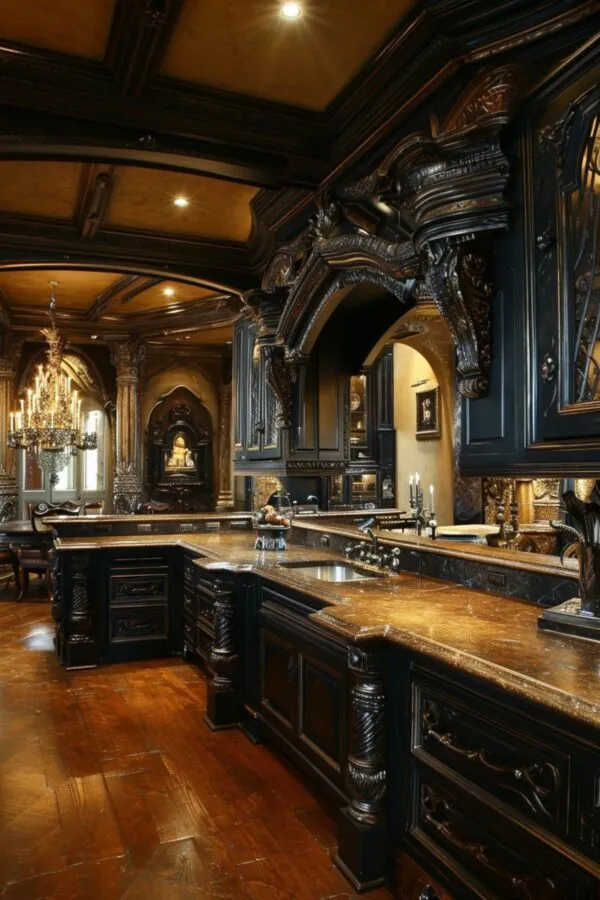
Achieving a cohesive Gothic theme involves balancing the various elements to create a harmonious design. Start with a clear vision for your kitchen, and consider the overall mood you want to achieve. Choose a consistent color palette and stick to it throughout the space. Select materials, hardware, and fixtures that complement each other and echo the historical style. Be mindful of the balance between dark and light, ensuring adequate lighting to avoid a gloomy atmosphere. Incorporate decorative elements and accessories that enhance the theme without making the space feel cluttered. The key is to plan carefully and consider all elements, allowing the space to tell a unified story that reflects the Gothic style’s dramatic aesthetic.
Blending Gothic with Modern Elements
Blending Gothic elements with modern design can create a unique and stylish kitchen. Consider pairing dark cabinets with sleek countertops and stainless steel appliances for a contrast. Incorporate modern lighting fixtures alongside Gothic-style accents to balance the historical and contemporary elements. Use a neutral color palette as a base and introduce Gothic details through accessories and decorative items. Combining vintage furniture with modern pieces, like a Gothic-style dining table with sleek chairs, adds visual interest. The key is to balance the styles to create a space that is both functional and visually appealing, reflecting a blend of old and new. This fusion of styles allows for a modern kitchen, with a Gothic historical touch.
Maintaining and Cleaning Gothic Decor
Maintaining a Gothic kitchen involves regular cleaning and care to preserve its elegance. Dust surfaces regularly to prevent build-up on dark furniture and decor. Use appropriate cleaning products for each material, such as wood polish for cabinets and gentle cleansers for stone countertops. Keep your hardware clean and dry, as wrought iron and other metals can rust or tarnish over time. Protect your antique furniture and accessories from direct sunlight and extreme temperatures. Regular maintenance will keep the Gothic kitchen looking its best. If you have stained glass, ensure it is cleaned. Also, any fabrics require cleaning as per the care label. By following these maintenance tips, you can preserve the unique beauty of your Gothic kitchen and enjoy its dramatic ambiance for years.
